This article post (Part 3) will conclude the series on "The Essenes and the Dead Sea Scrolls". We learned in Part 2 the Essenes were an apocalyptic movement within Judaism and were on a mission to help mankind [both Jew and Gentile]. Flavius Josephus describes them as living simple lives, strictly adhering to the law, communally owning property, and focusing on ritual purity. It has been generally agreed upon by the scholars of religion that the Essenes were the likely candidates for authorship of the Dead Sea Scrolls...
"The Essenes and Dead Sea Scrolls"
Part 3: Dead Sea Scrolls
Definition of the Dead Sea Scrolls:
(from Dictionary.com)
- noun - a number of leather, papyrus, and copper scrolls dating from c100 b.c. to a.d. 135, containing partial texts of some of the books of the Old Testament and some non-biblical scrolls, in Hebrew and Aramaic, and including apocryphal writings, commentaries, hymns, and psalms: found in caves near the NW coast of the Dead Sea beginning in 1947.
- - pl n - collection of manuscripts in Hebrew and Aramaic discovered in caves near the Dead Sea between 1947 and 1956. They are widely held to have been written between about 100 bc and 68 ad and provide important biblical evidence.
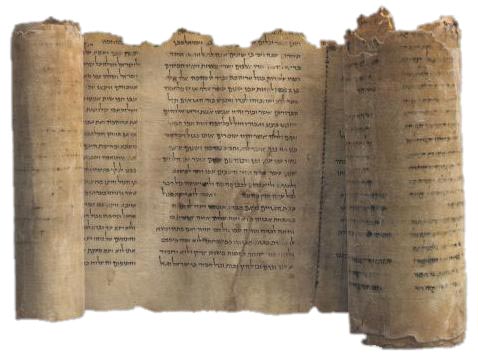 |
| Dead Sea Scroll |
It was not long after World War II came to an end that the 20th century would discover its greatest ancient find: the Dead Sea Scrolls. These ancient scrolls are a collection of 972 texts discovered between 1947 and 1956. The Dead Sea Scrolls are of great historical value; the religious and linguistic significance has preserved evidence of the diversity of religious thought in late Second Temple Judaism.
The Dead Sea Scrolls are written in four languages: Hebrew, Aramaic, Greek, and Nabataean, mostly on parchment, but with some written on papyrus and bronze. Carbon-dating of the scrolls is placed between 408 B.C. and 318 B.C. While the ancient scrolls are identified with the Essenes, other scholars argue that the writings were possibly penned by the Zadokite priests in Jerusalem. There are other theologians who claim the writings are the Essenes, who were renegade Zadokites to begin with. Hence the controversy of authorship and the recent interpretations currently being challenged.
 |
| Dead Sea Scroll Fragments |
- 40% are copies of text from the Hebrew Bible
- 30% are documents from the Second Temple Period
- 30% are sectarian manuscripts on the rules and beliefs of a particular group(s) within greater Judaism.
The ancient texts of the Dead Sea Scrolls provide scholars today with incredible insight on the religious developments within ancient Judaism just prior to the advent of Christianity. There are some interesting parallels between what they [Essenes] wrote and what later Christian authors would write, especially regarding messianic prophecies.
Discovery of the Dead Sea Scrolls:
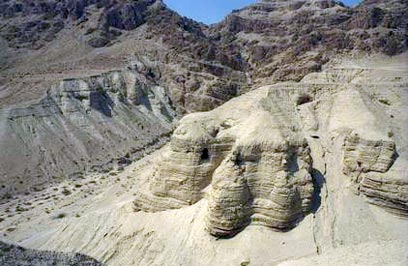 |
| The Caves of Qumran |
Fearing the poor creature had fallen through the hole (of what was the cave ceiling), he lowered himself carefully into the cavern. His discovery of clay pots that held the ancient leather documents [later to be named the "Dead Sea Scrolls"] would become the 'greatest ancient find of the 20th century'. Not sure what language the scrolls were written in, Muhammad took seven of the best scrolls [and leaving behind many fragments scattered on the cave floor] to an antiquities dealer in Bethlehem, who in turn turned the ancient scrolls over to a Syrian Orthodox Archbishop named Athanasius Yeshue Samuel (1909-1995).
| Examination of a Dead Sea Scroll |
Between the years of 1952 and 1956, thousands of fragile fragments of biblical and early Jewish documents were discovered in eleven (11) different caves near the site of Khirbet, Qumran, on the shores of the Dead Sea... hence the name "Dead Sea Scrolls". Archaeologists would go on to uncover thousands of ancient documents inside these other caves.
Revelation Within the Dead Sea Scrolls:
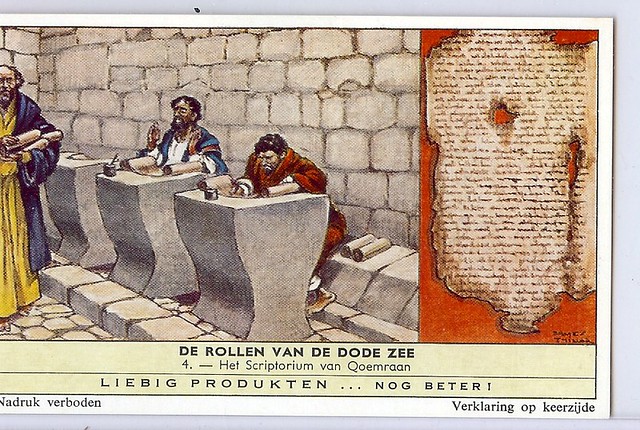 |
| Depiction of Essenes writing scrolls |
Within the ancient scrolls, the Sadducees are often referred to as Manasseh. The ancient scrolls suggest that the Sadducees (Manasseh) and the Pharisees (Ephraim) were religious communities that were distinct from the Essenes, who claimed to be the true tribe of Judah. Clashing ideologies and social positions between the Essenes and Sadducees are depicted in the Pesher on Nahum, which states:
“They [Manasseh] are the wicked ones...whose reign over Israel will be brought down...his wives, his children, and his infant will go into captivity. His warriors and his honored ones [will perish] by the sword.”
The reference to the Sadducees reigning over ancient Israel suggests that the Essenes blamed the aristocratic faction of the Sadducees for the downfall of ancient Israel and the siege of Jerusalem. The Dead Sea Scrolls brand the Sadduceean elite as those who broke the covenant with God in their rule of the Judean state, and thus became targets of divine revenge due to their impiety.
Influence of the Dead Sea Scrolls:
Many scholars, theologians and archaeologists have described the Dead Sea Scrolls as the most important discovery of the 20th century, which defines not only a great historical piece of writing, but a considerable influence upon mankind's understanding of the Bible. The Dead Sea Scrolls have shed tremendous light on the accuracy of the Holy Bible (Tanakh/Old Testament).
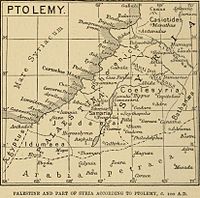 |
| Palestine c/100 AD according to Ptolemy (map by Claude Reignier Conder) |
Millar Burrows (1889-1980) writes: "It is a matter of wonder that through something like one thousand years the text underwent so little alteration. As I said in my first article on the scroll, ‘Herein lies its chief importance, supporting the fidelity of the Masoretic tradition."
 |
| The Nash Papyrus (2nd century BC) contains a portion of a pre-Masoretic Text, specifically the Ten Commandments and the Shema Yisrael prayer. |
Despite the thousand year gap between the ancient writings, scholars have found the Masoretic Text and Dead Sea Scrolls to be nearly identical. The Dead Sea Scrolls provide valuable evidence that the Old Testament had been accurately and carefully preserved. The ancient scrolls have definitely altered the way we look at ancient Judaism and the Bible, which is considerably significant to the Jewish and Christian religions.
List of the Dead Sea Scrolls:
The 972 manuscripts discovered at Qumran were found primarily in two separate formats: as scrolls and as fragments of previous scrolls and other texts. While the Dead Sea Scrolls are comprised of almost a thousand texts and would be incredibly difficult to condense into this article, the following Dead Sea Scrolls listed below are the seven (7) original scrolls which the Bedouin shepherd, Muhammad Ahmed el-Dhib, turned over to the proper authorities in 1947:
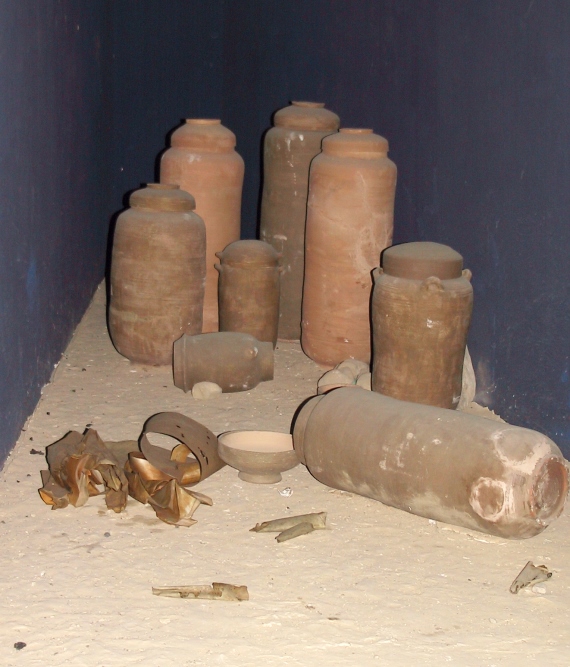 |
| Clay pots found at Qumran that housed the scrolls |
- Great Isaiah Scroll (1QIsaa)
- Second Copy of Isaiah (1QIsab)
- Community Rule Scroll (4QSa-j)
- Pesher on Habakkuk (1QpHab)
- the War Scroll (1QM)
- Thanksgiving Hymns (1QH)
- Genesis Apocryphon (1QapGen)
The Who's ? Right Blog has not been able to find a free 'complete' listing of the 972 Dead Sea Scrolls and fragments, but the following websites will expand further upon the list of ancient scrolls:
Dead Sea Scrolls on Display:
Temporary Display:
Small portions of the Dead Sea Scrolls collections have been put on temporary display at various locations around the world beginning in 1965. The majority of the 1965 exhibits took place mainly in the United States and the United Kingdom.
From 1993-2013, the scrolls have graced many museums and public venues, and granted an average of three to six months per length of exhibition. The current location of the Dead Sea Scrolls exhibit is at the Museum of Science in Boston, Massachusetts (USA) and will be on display until October 20, 2013.
 |
| Viewing the scrolls at the Museum of Science at Boston, Massachusetts |
From 1993-2013, the scrolls have graced many museums and public venues, and granted an average of three to six months per length of exhibition. The current location of the Dead Sea Scrolls exhibit is at the Museum of Science in Boston, Massachusetts (USA) and will be on display until October 20, 2013.
Long-Term Display:
 The majority of the Dead Sea Scrolls collections were moved to the Shrine of the Book (a part of the Israel Museum in Jerusalem) after its completion in April, 1965. The museum falls under the auspices of an official agency of the Israeli government known as the Israel Antiquities Authority. This permanent exhibition at the Israel Museum features a reproduction of the Great Isaiah Scroll and reproduced fragments that include the War Scroll, Community Rule, and the Thanksgiving Psalms Scroll.
The majority of the Dead Sea Scrolls collections were moved to the Shrine of the Book (a part of the Israel Museum in Jerusalem) after its completion in April, 1965. The museum falls under the auspices of an official agency of the Israeli government known as the Israel Antiquities Authority. This permanent exhibition at the Israel Museum features a reproduction of the Great Isaiah Scroll and reproduced fragments that include the War Scroll, Community Rule, and the Thanksgiving Psalms Scroll.
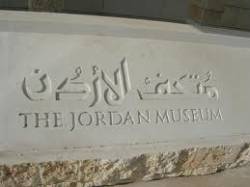 Some of the Dead Sea Scrolls collections are located in Amman, Jordan. Prior to 1967 [and the Six Day War], the ancient documents were stored in Amman rather than the Palestinian Archaeological Museum in East Jerusalem, which resulted in that part of the collection remaining in Jordanian hands under their Department of Antiquities. There has been an ongoing dispute between Jordan and Israel about the ownership of some of the Dead Sea Scrolls in Israeli possession and claim the Palestinian Museum in East Jerusalem did house some of the ancient scrolls prior to the Six Day War. The dispute continues unto this day as the Hashemite Kingdom of Jordan continues to claim rightful ownership of the ancient documents. Parts of the Jordanian Dead Sea Scrolls collection are anticipated to be on display at the Jordan Museum in Amman, Jordan in the near future. Among the exhibit items are artifacts from the Qumran site and the Copper Scroll.
Some of the Dead Sea Scrolls collections are located in Amman, Jordan. Prior to 1967 [and the Six Day War], the ancient documents were stored in Amman rather than the Palestinian Archaeological Museum in East Jerusalem, which resulted in that part of the collection remaining in Jordanian hands under their Department of Antiquities. There has been an ongoing dispute between Jordan and Israel about the ownership of some of the Dead Sea Scrolls in Israeli possession and claim the Palestinian Museum in East Jerusalem did house some of the ancient scrolls prior to the Six Day War. The dispute continues unto this day as the Hashemite Kingdom of Jordan continues to claim rightful ownership of the ancient documents. Parts of the Jordanian Dead Sea Scrolls collection are anticipated to be on display at the Jordan Museum in Amman, Jordan in the near future. Among the exhibit items are artifacts from the Qumran site and the Copper Scroll.
 The majority of the Dead Sea Scrolls collections were moved to the Shrine of the Book (a part of the Israel Museum in Jerusalem) after its completion in April, 1965. The museum falls under the auspices of an official agency of the Israeli government known as the Israel Antiquities Authority. This permanent exhibition at the Israel Museum features a reproduction of the Great Isaiah Scroll and reproduced fragments that include the War Scroll, Community Rule, and the Thanksgiving Psalms Scroll.
The majority of the Dead Sea Scrolls collections were moved to the Shrine of the Book (a part of the Israel Museum in Jerusalem) after its completion in April, 1965. The museum falls under the auspices of an official agency of the Israeli government known as the Israel Antiquities Authority. This permanent exhibition at the Israel Museum features a reproduction of the Great Isaiah Scroll and reproduced fragments that include the War Scroll, Community Rule, and the Thanksgiving Psalms Scroll. Some of the Dead Sea Scrolls collections are located in Amman, Jordan. Prior to 1967 [and the Six Day War], the ancient documents were stored in Amman rather than the Palestinian Archaeological Museum in East Jerusalem, which resulted in that part of the collection remaining in Jordanian hands under their Department of Antiquities. There has been an ongoing dispute between Jordan and Israel about the ownership of some of the Dead Sea Scrolls in Israeli possession and claim the Palestinian Museum in East Jerusalem did house some of the ancient scrolls prior to the Six Day War. The dispute continues unto this day as the Hashemite Kingdom of Jordan continues to claim rightful ownership of the ancient documents. Parts of the Jordanian Dead Sea Scrolls collection are anticipated to be on display at the Jordan Museum in Amman, Jordan in the near future. Among the exhibit items are artifacts from the Qumran site and the Copper Scroll.
Some of the Dead Sea Scrolls collections are located in Amman, Jordan. Prior to 1967 [and the Six Day War], the ancient documents were stored in Amman rather than the Palestinian Archaeological Museum in East Jerusalem, which resulted in that part of the collection remaining in Jordanian hands under their Department of Antiquities. There has been an ongoing dispute between Jordan and Israel about the ownership of some of the Dead Sea Scrolls in Israeli possession and claim the Palestinian Museum in East Jerusalem did house some of the ancient scrolls prior to the Six Day War. The dispute continues unto this day as the Hashemite Kingdom of Jordan continues to claim rightful ownership of the ancient documents. Parts of the Jordanian Dead Sea Scrolls collection are anticipated to be on display at the Jordan Museum in Amman, Jordan in the near future. Among the exhibit items are artifacts from the Qumran site and the Copper Scroll.
~ ~ ~ ~ ~ ~ ~ ~ ~ ~ ~ ~ ~ ~
"For without Thee no way is perfect and without Thy Will nothing is done."
- Dead Sea Scrolls, Community Rule (1QS)
More on the Dead Sea Scrolls:
Related Articles:
1 comment:
I wonder what kind of person is unaware that the DSS community called themselves many things, but NOT ESSENES, yet clings to the dying theory regardless?
Maybe you should read them. Zaddikim, Ebionim, The Way, Sons of Light, Hasidim, ets.
Not Essenes. De Vaux WANTED it to be true and everybody but true scholars cling to his theory.
The theory has no evidence that isn't contradicted by evidence that contradicts Essene beliefs, within the scrolls. And no linguistic support.
Post a Comment